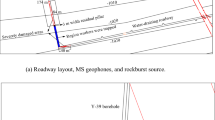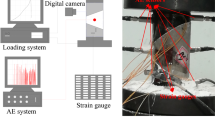Abstract
The existence of parting in coal can contribute to unstable slip and shear failure, and even rockburst of mining faces and sidewalls. In this work, the rockburst triggered by the slip and fracture of coal–parting–coal structure (CPCS) discontinuities subjected to dynamic stress was visually investigated by numerical simulation, and the stress and displacement as well as the corresponding vibration characteristics surrounding the parting during the rockburst were comprehensively analyzed. Eventually, the rockburst triggering mechanism was summarized. As a field testimony for verifying the numerical results, the “11.20” rockburst in the first parting zone of the 1307 working face of the Zhaolou coal mine (ZCM) was investigated in detail by microseismic (MS) tomography. The following main conclusions were obtained: (1) rockburst may be triggered by the slip and fracture of a CPCS subjected to dynamic stress with a violent ejection of a large number of parting fragments at a high speed. The peak particle velocity (PPV) 10 m/s can be regarded as a critical vibration velocity for rockburst warning; (2) during rockburst, the vibration characteristics of different positions surrounding the parting are closely associated with the coal and rock failure caused by the slip and fracture of the parting; and (3) based on the clustering of many high-energy MS sources in the parting zone combined with a high P-wave velocity, velocity gradient, stress concentration and strain energy, it was fully verified that the “11.20” rockburst was triggered by the slip and fracture of the wedge-shaped parting. Additionally, the sudden and sharp rise of the fault total area (FTA) can be regarded as a precursory sign to warn rockburst. The in situ observations lend credence to the numerical simulations.












Similar content being viewed by others
Abbreviations
- \(\Delta {\sigma _{\text{n}}}\) :
-
The normal effective stress increment
- σ 1 :
-
The maximum principal stress
- τ max :
-
The shear strength of contact
- \({\tau _{\text{s}}}\) :
-
The shear stress
- \(\phi\) :
-
The friction angle
- k n :
-
The normal stiffness
- \({k_{\text{s}}}\) :
-
The tangential stiffness
- \(C\) :
-
The cohesion
- G :
-
The shear modulus
- K :
-
The bulk modulus
- \(\Delta {u_{\text{n}}}\) :
-
The normal displacement increment
- u s :
-
The tangential displacement
References
Bandopadhyay C, Sheorey PR, Singh B, Ghose AK (1988) Stability of parting rock between level contiguous coal pillar workings. Int J Rock Mech Min Sci 25:307–320
Barton N (1976) The shear strength of rock and rock joints. Int J Rock Mech Min Sci 13:255–279
Barton N, Choubey V (1977) The shear strength of rock joints in theory and practice. Rock Mech 10:1–54
Bewick RP, Kaiser PK, Bawden WF (2014) Shear rupture under constant normal stiffness boundary conditions. Tectonophysics 634:76–90
Das AJ, Mandal PK, Bhattacharjee R, Tiwari S, Kushwaha A, Roy LB (2017) Evaluation of stability of underground workings for exploitation of an inclined coal seam by the ubiquitous joint model. Int J Rock Mech Min Sci 93:101–114
Deb D, Das KC (2014) A new doubly enriched finite element for modelling grouted bolt crossed by rock joint. Int J Rock Mech Min Sci 70:47–58
Fukuyama E, Xu S, Yamashita F, Mizoguchi K (2016) Cohesive zone length of metagabbro at supershear rupture velocity. J Seismol 20:1207–1215
Ghazvinian AH, Azinfar MJ, Geranmayeh Vaneghi R (2012) Importance of tensile strength on the shear behavior of discontinuities. Rock Mech Rock Eng 45:349–359
Goebel THW, Schorlemmer D, Becker TW, Dresen G, Sammis CG (2013) Acoustic emissions document stress changes over many seismic cycles in stick-slip experiments. Geophys Res Lett 40:2049–2054
Gong WL, Peng YY, He MC, Wang J (2015) Thermal image and spectral characterization of roadway failure process in geologically 45°inclined rocks. Tunn Undergr Sp Tech 49:156–173
Grasselli G (2006) Shear strength of rock joints based on quantified surface description. Rock Mech Rock Eng 39:295–314
Grenoble A, Haycocks C (1985) Design factors in near seam interactions. In: 3dth Conference on Ground Control Mining, W. Virginia University. Morgantown, pp 166–177
Gu R, Ozbay U (2014) Distinct element analysis of unstable shear failure of rock discontinuities in underground mining conditions. Int J Rock Mech Min Sci 68:44–54
Gu R, Ozbay U (2015) Numerical investigation of unstable rock failure in underground mining condition. Comput Geotech 63:171–182
Haycocks C, Karmis M, Ehgartner B (1982) Multiple seam mine design. State-of-the-art of ground control in longwall mining and mining subsidence. SME, New York, pp 59–65
Hedayat A, Pyrak NLJ, Bobet A (2014a) Precursors to the shear failure of rock discontinuities. Geophys Res Lett 41:5467–5475
Hedayat A, Pyrak-Nolte LJ, Bobet A (2014b) Precursors to the shear failure of rock discontinuities. Geophys Res Lett 41:5467–5475
Khazaei C, Hazzard J, Chalaturnyk R (2016) A discrete element model to link the microseismic energies recorded in caprock to geomechanics. Acta Geotech 11:1351–1367
Kulatilake P, Shou G, Huang T, Morgan R (1995) New peak shear strength criteria for anisotropic rock joints. Int J Rock Mech Min Sci Geomech Abstr 32:673–697
Ladanyi B, Archambault G (1969) Simulation of the shear behavior of a jointed rock mass. In: Proceedings of the 11th US symposium on rock mechanics. Berkeley, p 105–125
Li XM, Wang ZH, Zhang JW (2017) Stability of roof structure and its control in steeply inclined coal seams. Int J Min Sci Tech 27:359–364
Liu J, Wang EY, Song DZ, Wang SH, Niu Y (2015) Effect of rock strength on failure mode and mechanical behavior of composite samples. Arab J Geosci 8:4527–4539
Matcharashvili T, Chelidze T, Zhukova N, Mepharidze E (2011) Investigation of acoustic emission accompanying stick-slip movement of rock samples at different stiffnesses of spring–block system. Tribol Int 44:811–819
McLaskey GC, Lockner DA (2016) Calibrated acoustic emission system records M -3.5 to M -8 events generated on a saw-cut granite sample. Rock Mech Rock Eng 49:4527–4536
Mehrishal S, Sharifzadeh M, Shahriar K, Song JJ (2016) An experimental study on normal stress and shear rate dependency of basic friction coefficient in dry and wet limestone joints. Rock Mech Rock Eng 49:4607–4629
Meng FZ, Zhou H, Wang ZQ, Zhang LM, Kong L, Li SJ, Zhang CQ (2016) Experimental study on the prediction of rockburst hazards induced by dynamic structural plane shearing in deeply buried hard rock tunnels. Int J Rock Mech Min Sci 86:210–223
Naoi M, Nakatani M, Kgarume T et al (2015) Quasi-static slip patch growth to 20 m on a geological fault inferred from acoustic emissions in a South African gold mine. J Geophys Res Solid Earth 120:1692–1707
Park JW, Lee YK, Song JJ, Choi BH (2013) A constitutive model for shear behavior of rock joints based on three-dimensional quantification of joint roughness. Rock Mech Rock Eng 46:1513–1537
Peng SS, Chandra U (1980) Getting the most from multiple seam reserves. Coal Min Process 17:78–84
Petukhov IM, Linkov AM (1979) The theory of post failure deformations and the problem of stability in rock mechanics. Int J Rock Mech Min Sci Geomech Abstr 16:57–76
Reeves MJ (1985) Rock surface roughness and frictional strength. Int J Rock Mech Min Sci Geomech Abstr 22:429–442
Ryder JA (1988) Excess shear stress in the assessment of geologically hazardous situations. J S Afr I Min Metall 88:27–39
Selvadurai PA, Glaser SD (2015) Laboratory-developed contact models controlling instability on frictional faults. J Geophys Res Solid Earth 120:4208–4236
Sharifzadeh M (2005) Experimental and theoretical research on hydro-mechanical coupling properties of rock joint. Ph.D. dissertation, Kyushu University, Fukuoka, Japan
Suits LD, Sheahan TC, Seidel JP, Haberfield CM (2002) Laboratory testing of concrete-rock joints in constant normal stiffness direct shear. Geotech Test J 25:391–404
Wang JC, Jiang FX, Meng XJ, Wang XY, Zhu ST, Feng Y (2016) Mechanism of rock burst occurrence in specially thick coal seam with rock parting. Rock Mech Rock Eng 49:1953–1965
Webster S, Haycocks C, Karmis M (1984) Subsidence interaction effects in multi-seam mining. In: 2nd International Conference on Stability of Underground Mining. Lexington, pp 589–604
Williams TJ, Wideman CJ, Scott DF (1992) Case history of a slip-type rockburst. Pure Appl Geophys 139:627–637
Wu W, Zhao J (2014) A dynamic-induced direct-shear model for dynamic triggering of frictional slip on simulated granular gouges. Exp Mech 54:605–613
Xia CC, Tang ZC, Xiao WM, Song YL (2014) New peak shear strength criterion of rock joints based on quantified surface description. Rock Mech Rock Eng 47:387–400
Xie HP, Chen ZH, Zhou HW, Yi C, Chen ZJ (2005) Study on two-body mechanical model based on interaction between structural body and geo-body. Chin J Rock Mech Eng 24:457–464
Yoon JS, Zang A, Stephansson O (2012) Simulating fracture and friction of Aue granite under confined asymmetric compressive test using clumped particle model. Int J Rock Mech Min Sci 49:68–83
Zhao J (1997) Joint surface matching and shear strength part B, JRC-JMC shear strength criterion. Int J Rock Mech Min Sci 34:179–185
Zhao ZH, Wang WM, Wang LH, Dai CQ (2015) Compression-shear strength criterion of coal–rock combination model considering interface effect. Tunn Undergr Sp Tech 47:193–199
Acknowledgements
We gratefully wish to acknowledge the collaborative funding support from the National Natural Science Foundation of China (51574225), the Fundamental Research Funds for the Central Universities (YC150001), and a Project Funded by the Priority Academic Program Development of Jiangsu Higher Education Institutions (PAPD).
Author information
Authors and Affiliations
Corresponding author
Additional information
Publisher’s Note
Springer Nature remains neutral with regard to jurisdictional claims in published maps and institutional affiliations.
Rights and permissions
About this article
Cite this article
Lu, CP., Liu, GJ., Liu, Y. et al. Mechanisms of Rockburst Triggered by Slip and Fracture of Coal–Parting–Coal Structure Discontinuities. Rock Mech Rock Eng 52, 3279–3292 (2019). https://doi.org/10.1007/s00603-019-01769-w
Received:
Accepted:
Published:
Issue Date:
DOI: https://doi.org/10.1007/s00603-019-01769-w




